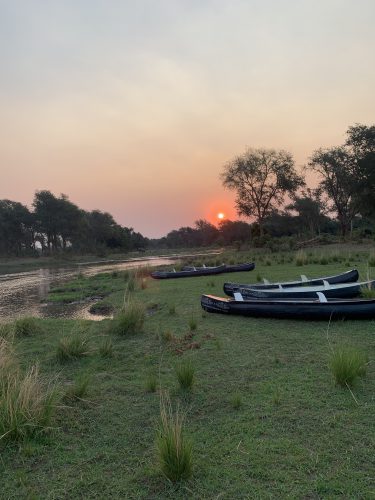In October I had the good fortune to spend two weeks exploring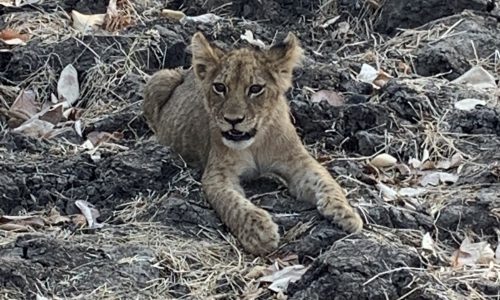 four of Zambia‘s incredible national parks and ending with some beach time on Malawi’s Likoma Island. Anouk traveled to Zambia in 2019 but her trip didn’t include Kafue so I was looking forward to visiting this lesser known region. October is the peak of dry season and, while hot, there is a certain energy in the air in anticipation of the rainy season. I enjoyed excellent game viewing and the water based activities were a great way to cool off. In the Lower Zambezi, I spent three nights at Sausage Tree then I visited Green Safaris properties in Livingstone, Kafue, South Luangwa and Malawi. Green Safaris incorporates the latest green technologies in camp design and guest experiences. From unique construction methods, solar power and amenities like electric game vehicles, e-bikes and an electric pontoon boat. I was excited to experience a “silent safari” on one of their e-vehicles.
four of Zambia‘s incredible national parks and ending with some beach time on Malawi’s Likoma Island. Anouk traveled to Zambia in 2019 but her trip didn’t include Kafue so I was looking forward to visiting this lesser known region. October is the peak of dry season and, while hot, there is a certain energy in the air in anticipation of the rainy season. I enjoyed excellent game viewing and the water based activities were a great way to cool off. In the Lower Zambezi, I spent three nights at Sausage Tree then I visited Green Safaris properties in Livingstone, Kafue, South Luangwa and Malawi. Green Safaris incorporates the latest green technologies in camp design and guest experiences. From unique construction methods, solar power and amenities like electric game vehicles, e-bikes and an electric pontoon boat. I was excited to experience a “silent safari” on one of their e-vehicles.
Lusaka and Lilongwe
My Zambia and Malawi adventure was book-ended with stays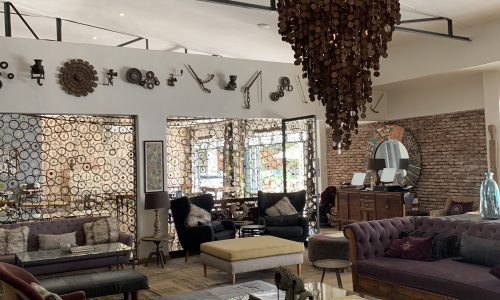 at the boutique hotels Latitude 15 in Lusaka and Latitude 13 in Lilongwe. Both hotels are filled with the work of local artists which accentuate the unique up-cycled industrial style décor. I found them to be perfect spots to unwind after a long flight from the USA or get a quick chance to shop and rest before a return flight home. You can have some quiet time by the pool or do a fun city sightseeing tour.
at the boutique hotels Latitude 15 in Lusaka and Latitude 13 in Lilongwe. Both hotels are filled with the work of local artists which accentuate the unique up-cycled industrial style décor. I found them to be perfect spots to unwind after a long flight from the USA or get a quick chance to shop and rest before a return flight home. You can have some quiet time by the pool or do a fun city sightseeing tour.
Lower Zambezi
Our light aircraft flight from Lusaka to Lower Zambezi took less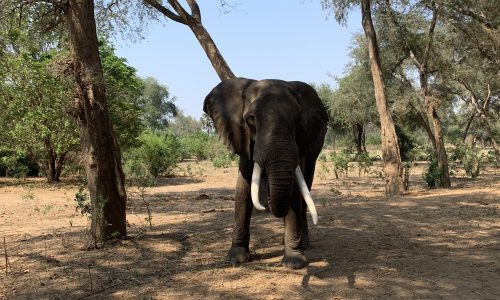 than an hour. Our guide met us at Jeki Airstrip and I was pleasantly surprised when we stopped at the river for a cocktail on the banks of the Zambezi, and then took a short boat ride to the dock at Sausage Tree Camp. Sited on the banks of the Zambezi opposite Mana Pools National Park in Zimbabwe, the camp is in a breathtakingly beautiful spot. The central dining and bar area is fronted by an enormous teak deck overlooking the Zambezi River dotted with small reed islands where you can see elephant, hippo and a wide variety of birds while you sip a sundowner or cup of coffee. There is also a lap pool in a separate section adjacent to the main area which provides another opportunity for game viewing while cooling off in the pool. The spacious tents also have river frontage, a private deck with seating, a plunge pool, as well as indoor (2 giant shower-heads, no less!) and outdoor showers. My nights were spent listening to the chorus of frogs and of course the grunting hippos. I was in heaven!
than an hour. Our guide met us at Jeki Airstrip and I was pleasantly surprised when we stopped at the river for a cocktail on the banks of the Zambezi, and then took a short boat ride to the dock at Sausage Tree Camp. Sited on the banks of the Zambezi opposite Mana Pools National Park in Zimbabwe, the camp is in a breathtakingly beautiful spot. The central dining and bar area is fronted by an enormous teak deck overlooking the Zambezi River dotted with small reed islands where you can see elephant, hippo and a wide variety of birds while you sip a sundowner or cup of coffee. There is also a lap pool in a separate section adjacent to the main area which provides another opportunity for game viewing while cooling off in the pool. The spacious tents also have river frontage, a private deck with seating, a plunge pool, as well as indoor (2 giant shower-heads, no less!) and outdoor showers. My nights were spent listening to the chorus of frogs and of course the grunting hippos. I was in heaven!
In the morning I woke up to a light knock and a fresh pot of 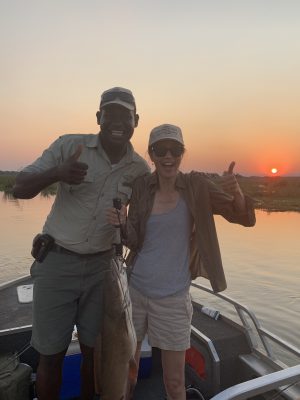 hot coffee with time to sit on my deck and watch the sunrise over the Zambezi. Then I was off on a game drive where we spent the morning watching two lioness and their playful cubs relaxing with full bellies after feasting on a fresh kill, under a tree behind them. On game drives, we saw elephant, leopard, lion — and then civet and porcupine on night drives. I was surprised by the large number of elephant and how relaxed they were around the vehicles. Besides game drives, we also went on a walking safari and enjoyed a bush breakfast with a curious bull elephant. I’d say the guided canoe trip on the Chifungulu channel, which branches off of the Zambezi, was my favorite activity. There is nothing better than silently gliding past herds of elephants, hippo pods, crocs and countless birds. Other highlights were the ‘water lunch’, a great way to keep cool with your feet soaking in the Zambezi while eating a delicious lunch. Fishing was another personal highlight. Reeling in a 25lb Vundu while the sun set over the Zambezi was thrilling! I also visited Sausage Tree’s smaller sister camp Potato Bush, just a short walk up the river, which offers a great balance of luxury and casualness and would be perfect for exclusive use by a family or small group. Guests at both camps are guaranteed private guiding and complimentary flights to and from Lusaka, Kafue, Mfuwe, or Livingstone with a 4 night stay.
hot coffee with time to sit on my deck and watch the sunrise over the Zambezi. Then I was off on a game drive where we spent the morning watching two lioness and their playful cubs relaxing with full bellies after feasting on a fresh kill, under a tree behind them. On game drives, we saw elephant, leopard, lion — and then civet and porcupine on night drives. I was surprised by the large number of elephant and how relaxed they were around the vehicles. Besides game drives, we also went on a walking safari and enjoyed a bush breakfast with a curious bull elephant. I’d say the guided canoe trip on the Chifungulu channel, which branches off of the Zambezi, was my favorite activity. There is nothing better than silently gliding past herds of elephants, hippo pods, crocs and countless birds. Other highlights were the ‘water lunch’, a great way to keep cool with your feet soaking in the Zambezi while eating a delicious lunch. Fishing was another personal highlight. Reeling in a 25lb Vundu while the sun set over the Zambezi was thrilling! I also visited Sausage Tree’s smaller sister camp Potato Bush, just a short walk up the river, which offers a great balance of luxury and casualness and would be perfect for exclusive use by a family or small group. Guests at both camps are guaranteed private guiding and complimentary flights to and from Lusaka, Kafue, Mfuwe, or Livingstone with a 4 night stay.
Livingstone
My next stop was Livingstone to take a dip in the infamous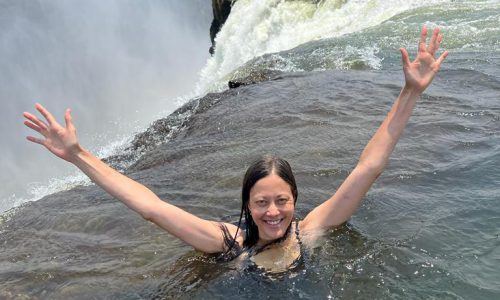 Devil’s Pool, a natural rock infinity pool on the edge of Victoria Falls. We met up with our pilot Ignatius from United Air Charter who would fly us around in his Cessna Caravan for the duration of the trip. For groups of 9 or less with a healthy budget, I’d highly recommend chartering a plane. It made for seamless, relaxed transfers. In just under two hours we found ourselves nervously sipping tea at the United Air Charter lounge in Livingstone while glancing at the mist from the Falls in the distance knowing we’d soon be whisked off to Livingstone Island to swim in Devil’s Pool.
Devil’s Pool, a natural rock infinity pool on the edge of Victoria Falls. We met up with our pilot Ignatius from United Air Charter who would fly us around in his Cessna Caravan for the duration of the trip. For groups of 9 or less with a healthy budget, I’d highly recommend chartering a plane. It made for seamless, relaxed transfers. In just under two hours we found ourselves nervously sipping tea at the United Air Charter lounge in Livingstone while glancing at the mist from the Falls in the distance knowing we’d soon be whisked off to Livingstone Island to swim in Devil’s Pool.
The boat ride out to the island set the tone for the excitement to come and got my adrenaline pumping as our boat sped toward the roaring Falls, swerving to avoid rock outcroppings. While not on my bucket list, as I have a fear of heights, after going through the safety briefing there was no turning back. Getting to Devil’s Pool, at the edge of the Falls, involves walking on a rocky path and swimming across the river. There are ropes to hold onto and guides to help along the way. Once at the edge of the pool, we slid into the water and swam across to the edge. If you zoom in on any of my photos, you’ll notice I am clutching the guide’s hand VERY tightly but that’s what they are there for. While I couldn’t muster up the courage to look over the edge I did take the obligatory photo with my hands in the air. I would definitely do it again!
After our exhilarating swim, we stopped for a tour of the Falls 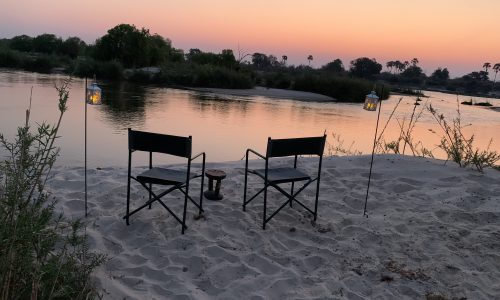 with our guide from Tongabezi. Visiting during the dry season means I didn’t get soaked from the spray, which might have been welcome given how hot it was. The enormity of the crack in the earth is certainly felt from this perspective as you walk into the gorge and across the knife bridge. From here one can view the Victoria Falls Bridge linking Zambia and Zimbabwe and where you often see bungee jumpers taking the plunge.
with our guide from Tongabezi. Visiting during the dry season means I didn’t get soaked from the spray, which might have been welcome given how hot it was. The enormity of the crack in the earth is certainly felt from this perspective as you walk into the gorge and across the knife bridge. From here one can view the Victoria Falls Bridge linking Zambia and Zimbabwe and where you often see bungee jumpers taking the plunge.
My visit to Green Safaris properties began with a night at Tongabezi, just upriver from the Falls on the banks of the Zambezi featuring 11 cottages and houses. I was in the lovely Bird House which was beautifully decorated and I could either open the glass folding doors leading onto the deck – or turn on the air conditioner. We enjoyed a delicious lunch on arrival, and a quick site visit to Sindabezi, the more traditional Zambian-style tented camp on a private island in the river with a Robinson Crusoe vibe. It is perfect for exclusive use for families with older kids/teens. Then it was time for sundowners at the Bar on the Sandbar where you can put your toes in the sand and enjoy a drink in a magical setting. The next morning we had a joyful visit to the Tujatane Trust School located on the far end of the property. Started as a preschool for the employees more than 25 years ago by the founders of Tongabezi, it has grown into an award-winning primary school for around 280 children, all from surrounding disadvantaged communities.
Kafue
Set in the heart of western Zambia, Kafue National Park is 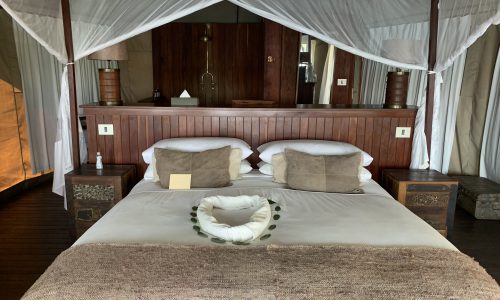 the country’s largest and oldest National Park covering about 8,650 square miles. The Kafue River and its tributaries, the Lufupa and Lunga, form the lifeblood of the reserve with the annual summer flood of Lufupa creating an impressive floodplain delta. The floodplains, rivers and woodland support an impressive array of animal and birdlife. The park is also known for its diversity of antelope and is home to 21 different species.
the country’s largest and oldest National Park covering about 8,650 square miles. The Kafue River and its tributaries, the Lufupa and Lunga, form the lifeblood of the reserve with the annual summer flood of Lufupa creating an impressive floodplain delta. The floodplains, rivers and woodland support an impressive array of animal and birdlife. The park is also known for its diversity of antelope and is home to 21 different species.
I stayed at Ila Lodge located on the east bank of the Kafue River outside the park on privately owned property, close to the Hook Bridge which gives access to Kafue National Park. For easier access, we took the electric pontoon boat across the river as the vehicles are kept on the park side. While slower than the small boats it was quiet and comfortable and is also available for sunset cruises. The camp comprised 10 classic tents with indoor and outdoor showers and a deck overlooking the river with a beautiful expansive main area and infinity pool. Seeing a leopard with a fresh kill on the way to camp from the airstrip was an exciting introduction to Kafue. I also saw elephant, hippo, bushbuck, lion and spent some time with a lioness and her cubs. My favorite sighting was while walking up to the main area for breakfast I spotted two male lions walking along the opposite river bank. One evening we were joined by Matt Becker from the Zambian Carnivore Program who told us about their important conservation programs in Zambia.
Ila was one of my favorite camps and I wished I could have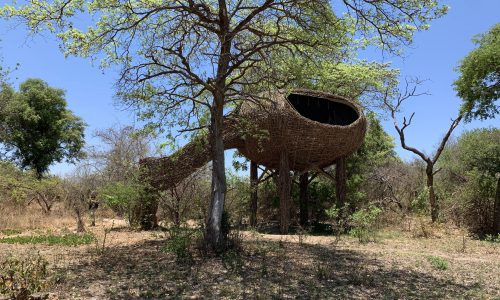 spent more time there but we flew 20 minutes north to Busanga Plains, known as the “jewel in the crown” of Kafue, for a site visit of Green Safari’s newest property – Chisa Busanga. Chisa is the Nyanja word for ‘birds nest’ and the rooms were inspired by the weaver bird nests that decorate the trees there. Sitting on a small tree-lined island, the camp uses solar power as do the game drive vehicles and e-bikes. Up a few short flights of stairs, you find yourself in a cozy nest with expansive views overlooking the plains. With the windows open the rooms were surprisingly cool despite the heat of the day. One of the “nests” came equipped with an elevator. There was a small plunge pool and a lovely main area tent where we had a delicious lunch with some very tasty gluten free noodles – I’d say the best I’ve tasted! I saw puku, hippo, red lechwe, oribi, buffalo, and wildebeest. There is also a healthy cheetah and wild dog population. Ideally I would spend a minimum of three days each at Ila and Chisa to have more time to explore Kafue.
spent more time there but we flew 20 minutes north to Busanga Plains, known as the “jewel in the crown” of Kafue, for a site visit of Green Safari’s newest property – Chisa Busanga. Chisa is the Nyanja word for ‘birds nest’ and the rooms were inspired by the weaver bird nests that decorate the trees there. Sitting on a small tree-lined island, the camp uses solar power as do the game drive vehicles and e-bikes. Up a few short flights of stairs, you find yourself in a cozy nest with expansive views overlooking the plains. With the windows open the rooms were surprisingly cool despite the heat of the day. One of the “nests” came equipped with an elevator. There was a small plunge pool and a lovely main area tent where we had a delicious lunch with some very tasty gluten free noodles – I’d say the best I’ve tasted! I saw puku, hippo, red lechwe, oribi, buffalo, and wildebeest. There is also a healthy cheetah and wild dog population. Ideally I would spend a minimum of three days each at Ila and Chisa to have more time to explore Kafue.
South Luangwa
My journey continued down to South Luangwa National Park, considered one of the greatest wildlife sanctuaries in the world with 60 different mammal species and over 400 bird species. A highlight was stopping at Tribal Textiles and Mulberry Mongoose for some shopping on the drive to the lodge.
I stayed at Shawa Luangwa Camp, located in the game 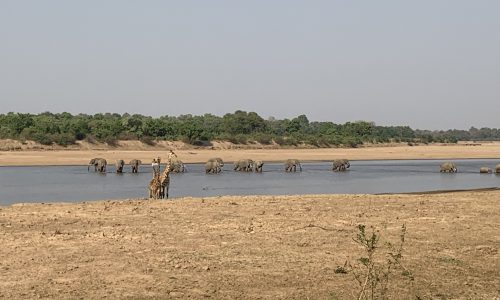 management area north of Mfuwe. The camp is named after top guide Jacob Shawa whose unparalleled enthusiasm and knowledge of the park are the reason to stay at this camp. “Silent safaris” in the camp’s electric land cruisers were a highlight as we silently glided along. Without the abrupt stop and starts and smells of diesel, we were able to focus on the sounds of animal and birdlife. Game drive highlights included tracking a leopard in the dappled light of the mahogany woods and a spectacular view of an oxbow lagoon with both elephant and giraffe crossing at the same time. The park allows self driving so you can expect to see other vehicles.
management area north of Mfuwe. The camp is named after top guide Jacob Shawa whose unparalleled enthusiasm and knowledge of the park are the reason to stay at this camp. “Silent safaris” in the camp’s electric land cruisers were a highlight as we silently glided along. Without the abrupt stop and starts and smells of diesel, we were able to focus on the sounds of animal and birdlife. Game drive highlights included tracking a leopard in the dappled light of the mahogany woods and a spectacular view of an oxbow lagoon with both elephant and giraffe crossing at the same time. The park allows self driving so you can expect to see other vehicles.
South Luangwa is famous for its walking safaris so I knew I 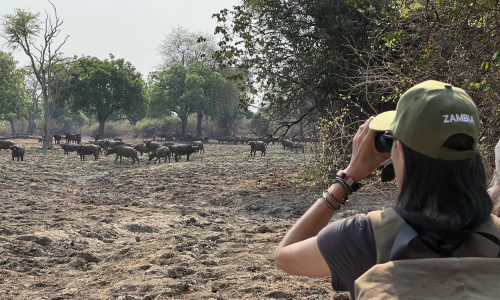 didn’t want to miss my chance to walk with Jacob as my guide. I spent a memorable hour sitting on the banks of the Luangwa River watching and listening to the carmine bee-eaters, having close encounters with zebras, Thornicroft giraffes (only found here), kudu, puku, a herd of buffalo as well as witnessing the brilliant green dazzle of lovebirds, which was spectacular to see.
didn’t want to miss my chance to walk with Jacob as my guide. I spent a memorable hour sitting on the banks of the Luangwa River watching and listening to the carmine bee-eaters, having close encounters with zebras, Thornicroft giraffes (only found here), kudu, puku, a herd of buffalo as well as witnessing the brilliant green dazzle of lovebirds, which was spectacular to see.
The tents, situated on the banks of the Luangwa River, sit on stilts with a bathtub in the corner, an outdoor shower and seating area. While smaller and more rustic than the other camps, the tents have flaps that open up on all sides so you are completely immersed in the surround sound of the bush. I would recommend at least four nights in South Luangwa and for variety, split the time between two camps.
Likoma Island, Malawi
Finally, I was off to Likoma Island, located on Lake Malawi, for 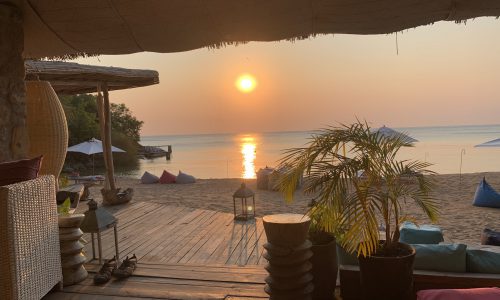 some beach time at the unique and delightful Kaya Mawa. Considering the remoteness and exclusivity of the resort, it was easily accessible from Zambia and a great way to end my safari. The vibe at Kaya Mawa is very relaxed from the moment you plop down into a cozy bean bag while sipping your refreshing welcome drink. The rooms are set into the rocks, once inside you’ll find whitewashed walls and floors with boulder outcroppings. The decor consists of glass beads, chandeliers, and fabrics all handmade at the Katundu workshop from sustainable and recyclable materials mostly from the lodge and the lake itself. The workshop is located just behind Ndomo, an exclusive use house that is perfect for groups. Visiting and shopping at Katundu is one of the activities on offer along with kayaking, SUP, scuba diving (extra cost), sailing, waterskiing, wakeboarding, fishing and sundowner boat rides.
some beach time at the unique and delightful Kaya Mawa. Considering the remoteness and exclusivity of the resort, it was easily accessible from Zambia and a great way to end my safari. The vibe at Kaya Mawa is very relaxed from the moment you plop down into a cozy bean bag while sipping your refreshing welcome drink. The rooms are set into the rocks, once inside you’ll find whitewashed walls and floors with boulder outcroppings. The decor consists of glass beads, chandeliers, and fabrics all handmade at the Katundu workshop from sustainable and recyclable materials mostly from the lodge and the lake itself. The workshop is located just behind Ndomo, an exclusive use house that is perfect for groups. Visiting and shopping at Katundu is one of the activities on offer along with kayaking, SUP, scuba diving (extra cost), sailing, waterskiing, wakeboarding, fishing and sundowner boat rides.
As I was still on safari schedule and not wanting to miss out on  the beauty of Lake Malawi, I rose early each morning, grabbed my snorkel and went kayaking. Lake Malawi is home to more than 700 species of cichlids, which are the colorful fish found in freshwater aquariums. It’s easy to forget that you are on a lake rather than the ocean when you see the bright blue fish swim past you while snorkeling. My room was called Mbumba, perched at the very top of the boulders but well worth the climb up the stone steps to see the incredible views of the lake while listening to the chittering of the weaver birds with their beautifully woven nests hanging from the trees surrounding my private patio and plunge pool. Every room is slightly different, with its own charm. Some of the rooms featured docks make it convenient to jump right into the lake. The food was the best I had on the trip from fresh salads to amazing risotto.
the beauty of Lake Malawi, I rose early each morning, grabbed my snorkel and went kayaking. Lake Malawi is home to more than 700 species of cichlids, which are the colorful fish found in freshwater aquariums. It’s easy to forget that you are on a lake rather than the ocean when you see the bright blue fish swim past you while snorkeling. My room was called Mbumba, perched at the very top of the boulders but well worth the climb up the stone steps to see the incredible views of the lake while listening to the chittering of the weaver birds with their beautifully woven nests hanging from the trees surrounding my private patio and plunge pool. Every room is slightly different, with its own charm. Some of the rooms featured docks make it convenient to jump right into the lake. The food was the best I had on the trip from fresh salads to amazing risotto.
The smoldering Zambian sunsets are forever ingrained in my memory. Watching a giant ball of orange sink below the horizon is a breathtaking sight to see. My safari experience in Zambia was top notch from the expert guiding, incredible diversity of wildlife to the unique ecosystems. A special thanks to Johann of Far Country Collection for hosting this amazing trip. Check out some of our Zambia itineraries and give us a call to start planning your Zambia adventure.
